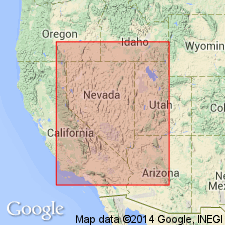
- Usage in publication:
-
- Amargosa Alloformation
- Modifications:
-
- Named
- Dominant lithology:
-
- Tephra
- Gravel
- Sand
- Silt
- Clay
- AAPG geologic province:
-
- Great Basin province
Summary:
Named Amargosa Alloformation and assigned, along with (ascending) Spanish Trail, Greenwater Fan, and Shoshone Springs Alloformations (all new), to late Miocene to late Pleistocene Lake Tecopa Allogroup (new). Name origin not stated. Found in vicinity of intermittent Amargosa River and towns of Shoshone and Tecopa, ancient Lake Tecopa area, eastern Mojave Desert, Inyo Co., east-central CA. Comprises late Pleistocene (620 ka) Lava Creek B tephra layer and younger unnamed lacustrine sediments ranging from pebble gravel to sand, silt, and clay much less altered by authigenesis than older strata; commonly unconsolidated or poorly consolidated, locally well cemented by lake or spring carbonate, especially in northern part of Tecopa basin and near former spring and seepage areas, some of the latter forming mounds of tufa. Thickness is roughly 55 m [inferred]. Discontinuously underlies late Pleistocene (160 ka) unnamed tephra layer. Discontinuously overlies Pleistocene (738 to 620 ka) Shoshone Springs Alloformation. Age is late Pleistocene based on well-dated tephra layers (Sarna-Wojcicki and others, 1987; and Chapter 6 in this volume; Sarna-Wojcicki, personal communication, 1990).
Source: GNU records (USGS DDS-6; Menlo GNULEX).
For more information, please contact Nancy Stamm, Geologic Names Committee Secretary.
Asterisk (*) indicates published by U.S. Geological Survey authors.
"No current usage" (†) implies that a name has been abandoned or has fallen into disuse. Former usage and, if known, replacement name given in parentheses ( ).
Slash (/) indicates name conflicts with nomenclatural guidelines (CSN, 1933; ACSN, 1961, 1970; NACSN, 1983, 2005, 2021). May be explained within brackets ([ ]).

